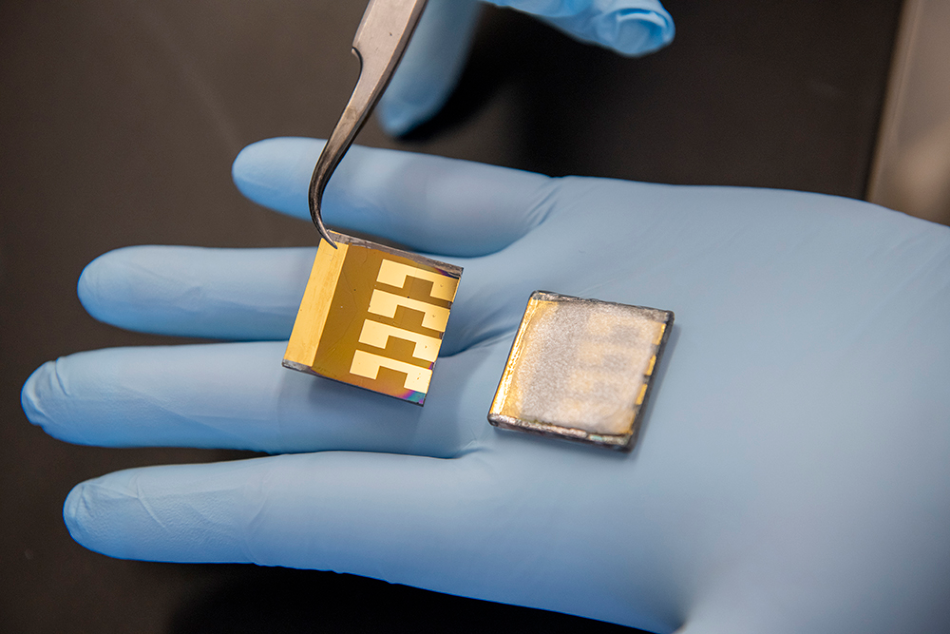Feb 20 2020
A team of researchers from the U.S. Department of Energy’s (DOE) National Renewable Energy Laboratory (NREL) in Golden, Colorado and from Northern Illinois University has made a promising breakthrough in the fabrication of hybrid perovskite solar cells. The study was reported in the Nature journal on February 19th, 2020.
 Two laboratory solar cell samples, one (right) with a protective lead-absorbing film applied to the backside. Image credit: Northern Illinois University.
Two laboratory solar cell samples, one (right) with a protective lead-absorbing film applied to the backside. Image credit: Northern Illinois University.
Perovskite solar cells are regarded as emerging stars in the area of solar energy and change light into electricity. They could be produced more easily and cost-effectively when compared to conventional silicon-based solar cells. At the least, perovskite solar cells have shown similar levels of efficiency on a small scale in laboratory environments.
However, these solar cells are still plagued by major challenges before they can turn out to be a viable commercial technology.
One significant difficulty is the application of lead. Water-dissolvable lead is present in a majority of the top-performing hybrid perovskite solar cells, and this fact increases concerns over the possible leakage of lead occurring from damaged cells.
A research team, headed by Tao Xu of NIU and Kai Zhu of NREL, has now created a new method to sequester the lead used for making perovskite solar cells and reduce the possible harmful leakage by using lead-absorbing films on the back and front of the solar cell.
The lead toxicity issue has been one of the most vexing, last-mile challenges in the perovskite solar cell field. We think we have a highly promising remedy to this problem—and it could be a game-changer. In the event of a damaged cell, our device captures the great majority of the lead, preventing it from leaching into groundwater and soils. The films that we use are insoluble in water.
Tao Xu, Professor, Department of Chemistry and Biochemistry, Northern Illinois University
The researchers informed that under situations of extreme solar cell damage in a laboratory environment, the lead-absorbing films sequestered a lead leakage of 96%. The researchers’ experiments additionally indicate that the performance or long-term operation stability of the solar cells is not negatively affected by the lead-absorbing layers.
Perovskite solar cells utilize a group of crystal structures that are analogous to that seen in the perovskite mineral, and hence, they were named as such. Within these solar cells, the perovskite-structured compound is most often a material based on hybrid organic-inorganic lead halide.
It was only about 10 years ago that researchers started to examine these crystal structures for applications in solar cells and since then have quickly boosted their conversion efficiency of solar energy. Perovskites can be produced utilizing room-temperature chemical solutions, while conventional silicon solar cells are created with accurate procedures using increased temperatures.
The recently devised “on-device sequestration approach” can be quickly integrated into today’s configurations of perovskite solar cells, added Xu.
A see-through lead-absorbing film is applied to a conducting glass placed before the solar cell. Although the sequestration film contains powerful lead-binding phosphonic acid groups, it does not impede the solar cell from capturing light.
A less costly polymer film combined with lead-chelating agents is utilized on the back of the metal electrode, which does not require transparency.
The materials are off-the-shelf, but they were never used for this purpose. Light must enter the cell to be absorbed by the perovskite layer, and the front-side film actually acts as an anti-reflection agent, improving transparency just a bit.
Tao Xu, Professor, Department of Chemistry and Biochemistry, Northern Illinois University
Lead leakage tests involved hammering and breaking the front-side glass of solar cells that measure 2.5 x 2.5 cm, and then using a razor blade to scratch the backside of the solar cells, before immersing them into water. Due to water ingress, the films can absorb most of the lead in severely impaired cells.
It is worth noting that the demonstrated lead-sequestration approach is also applicable to other perovskite-based technologies such as solid-state lighting, display, and sensor applications.
Kai Zhu, Senior Scientist, National Renewable Energy Laboratory
A patent has been applied for the researchers’ lead-absorbing films. Other authors of the study include graduate student Xun Li from Northern Illinois University, Haiying He from Valparaiso University, and Fei Zhang and Joseph Berry from the National Renewable Energy Laboratory.
The study was funded by the DOE Solar Energy Technologies Office and the National Science Foundation. The Solar Energy Technologies Office is also offering financial assistance for additional development of the lead-sequestration films meant for hybrid perovskite solar cells.